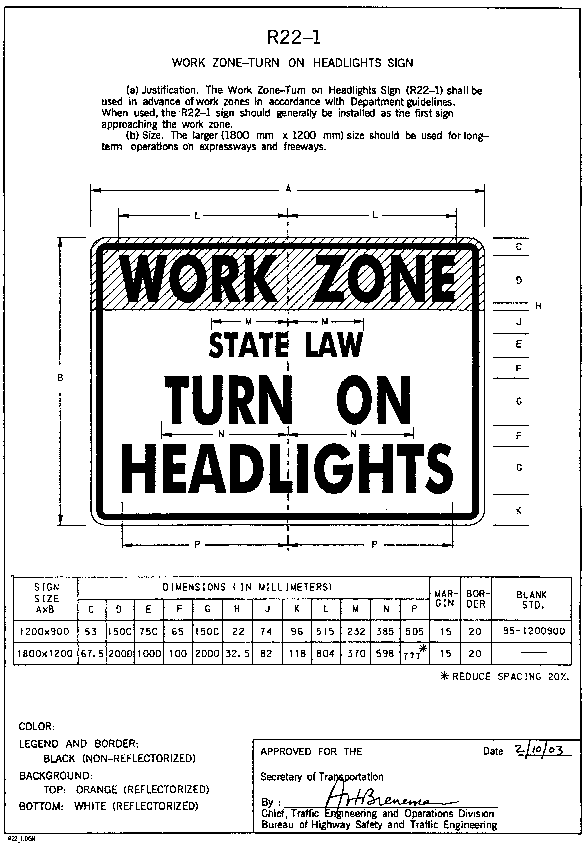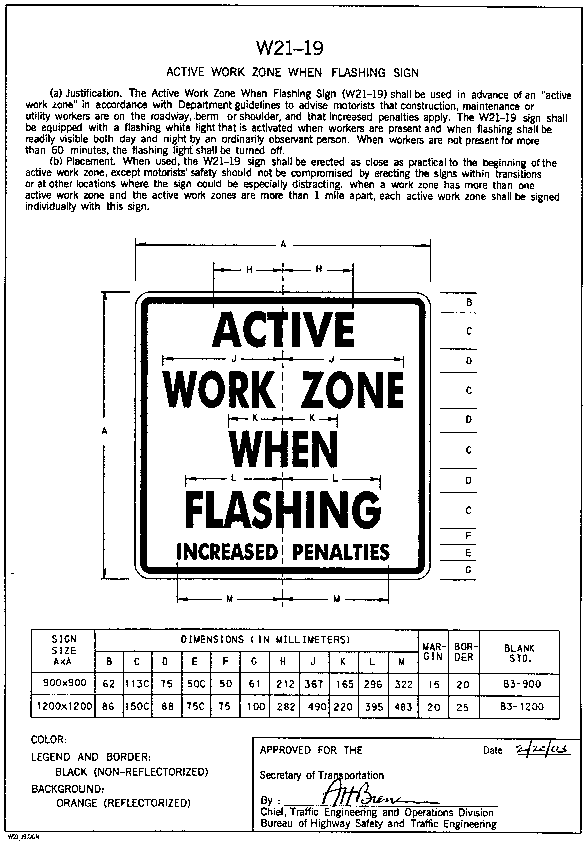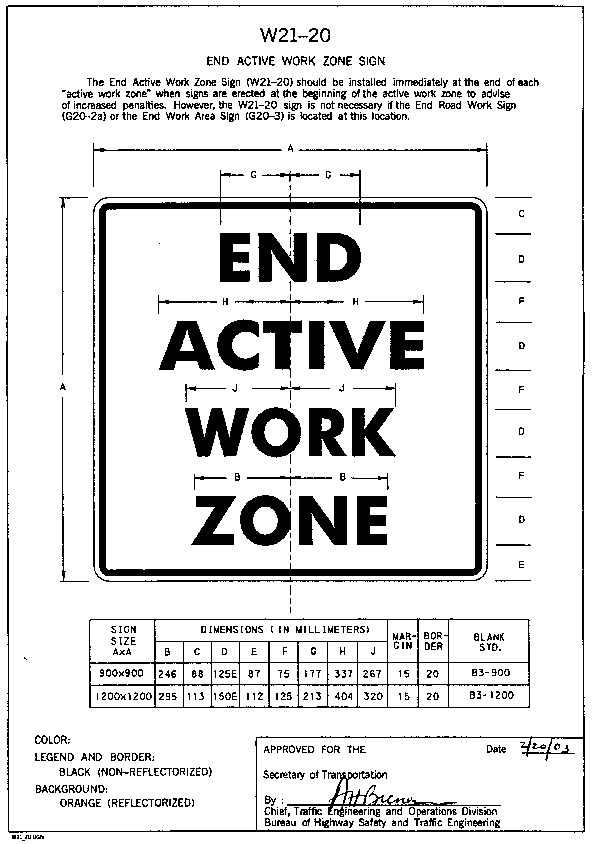STATEMENTS OF POLICY
Title 67--TRANSPORTATION
DEPARTMENT OF TRANSPORTATION
[67 PA. CODE CH. 204]
Additional Traffic-Control Devices in Highway Work Zones--Statement of Policy
[33 Pa.B. 5619] The Department of Transportation adopts this statement of policy in response to the requirements in the act of December 23, 2002 (P. L. 1982, No. 229) (Act 229). These guidelines are designed to improve safety in highway work zones by requiring drivers to light their vehicles' headlights and by delineating the ''active work zones'' where motorists are exposed to increased penalties for moving violations due to the presence of workers. The signs and lights specified are in addition to the traffic-control devices required by Chapter 203 (relating to work zone traffic control) and apply to all construction, maintenance and utility operations on all public highways within this Commonwealth.
Since the publication of the statement of policy at 33 Pa.B. 1361 (March 15, 2003), the Department has received further suggestions and comments and has continued to reevaluate the guidance provided. The amendments to the statement of policy are the result of the reevaluation.
Effective Date
This amended statement of policy will be effective upon publication in the Pennsylvania Bulletin.
Contact Person
The contact person for this statement of policy is Arthur Breneman, Department of Transportation, Bureau of Highway Safety and Traffic Engineering, P. O. Box 2407, Harrisburg, PA 17105-2047, (717) 787-3620, fax (717) 783-8012.
Authority
This statement of policy is adopted under the authority in section 21 of Act 229.
Order
The Department, acting under the authorizing statute, orders that:
(a) The regulations of the Department, 67 Pa. Code Chapter 204, are amended by amending a statement of policy in §§ 204.1 and 204.3 and by deleting § 204.4 to read as set forth in Annex A.
(b) The Secretary of the Department shall certify this order and Annex A and deposit them with the Legislative Reference Bureau as required by law.
(c) This order shall take effect upon publication in the Pennsylvania Bulletin.
ALLEN D. BIEHLER, P. E.,
Secretary
Fiscal Note: 18-SOP-386. (1) Motor License Fund;
Highway & Safety
Highway Improvements Maintenance (2) Implementing Year 2003-04 is $6,300,000 $1,600,000 (3) 1st Succeeding Year 2004-05 is $6,300,000 $1,000,000 2nd Succeeding Year 2005-06 is $6,300,000 $1,000,000 3rd Succeeding Year 2006-07 is $6,300,000 $1,000,000 4th Succeeding Year 2007-08 is $6,300,000 $1,000,000 5th Succeeding Year 2008-09 is $6,300,000 $1,000,000
Highway & Safety
ImprovementsHighway
MaintenanceSecondary Road--
Maintenance
& Resurfacing(4) 2002-03 Program-- $188,000,000 $666,000,000 $64,562,000 2001-02 Program-- $196,750,000 $662,750,000 $61,870,000 2000-01 Program-- $174,022,000 $634,819,000 $62,279,000 (8) recommends adoption. A portion of the expected costs to the Highway Maintenance appropriation may be charged to the Secondary Road--Maintenance and Resurface executive authorization. Also, the Department of Transportation expects to receive Federal funds which would offset these costs. It is estimated that annual costs to the Turnpike Commission for this program will be $600,000.
Annex A
TITLE 67. TRANSPORTATION
PART I. DEPARTMENT OF TRANSPORTATION
Subpart A. VEHICLE CODE PROVISIONS
ARTICLE VIII. ADMINISTRATION AND ENFORCEMENT
CHAPTER 204. GUIDELINES TO IMPLEMENT ACT 229 OF 2002 ADDITIONAL TRAFFIC-CONTROL DEVICES IN HIGHWAY WORK ZONES--STATEMENT OF POLICY § 204.1. Purpose and application.
(a) This chapter is in response to the requirements of Act 229. Specifically, this chapter is designed to improve safety in highway work zones by requiring drivers to light their vehicles' headlights; and by delineating those ''active work zones'' where motorists are exposed to increased penalties for moving violations due to the presence of workers.
(b) The signs and lights specified in this chapter are in addition to the traffic-control devices required by this title. However, there are times when installing additional traffic-control devices would be extremely difficult and other times when it could be counterproductive from a safety and operational perspective. Therefore, in the interest of safety and in keeping with the legislative intent of the law, the application of this chapter is discretionary for the following work zones:
(1) Mobile operations, where the work moves intermittently or continuously.
(2) Daytime stationary work where the daily duration of the construction, maintenance, or utility operation is less than 12 hours, and all traffic-control devices are removed at the completion of the daily operation.
(3) Work on roadways with a posted speed limit of 25 mph or less.
(4) Work being performed in response to emergency conditions such as major storm emergencies.
§ 204.3. General.
Except as noted in § 204.1(b) (relating to purpose and application), the following actions shall be taken:
(1) Erect the WORK ZONE - TURN ON HEADLIGHTS Sign (R22-1) prior to each work zone. Install the R22-1 sign as the first sign on each primary approach to the work zone, typically at a distance of 250 to 1,000 feet prior to the first warning sign. Use smaller advance distances on low-speed highways and the larger advance distances on high-speed roadways including all expressways and freeways. If work begins near a border to this Commonwealth, the R22-1 sign for traffic coming into this Commonwealth should be installed within this Commonwealth.
(2) Delineate ''active work zones'' by signs and lights as defined in this chapter to establish those areas where double fines and other increased penalties apply. Do not consider a construction, maintenance or utility operation as an ''active work zone'' when either of the following exist:
(i) None of the work is on the roadway or shoulder.
(ii) All workers are protected by a concrete barrier and no ingress or egress to the work area is through an opening in the concrete barrier.
(3) Erect the ACTIVE WORK ZONE WHEN FLASHING Sign (W21-19) as close as practical to the beginning of the ''active work zone.'' Do not compromise motorists' safety by erecting the sign within a transition or at a location where the sign could be especially distracting to motorists or could jeopardize the safety of motorists, or at a location where workers are put at risk when they may need to turn the light on and off. When a construction, maintenance or utility project has more than one active work zone and the active work zones are separated by a distance of more than 1 mile, erect signs for each active work zone. All W21-19 signs shall be installed on either temporary sign posts or on Type III barricades.
(4) Attach a white Type B high-intensity flashing light to the upper portion of each ACTIVE WORK ZONE WHEN FLASHING Sign (W21-19). Activate the light only when workers are present, and deactivate it when workers are not present for 60 minutes or more. Effec- tive January 1, 2004, all white Type B high-intensity flashing lights sold for use in this Commonwealth shall be of a type approved by the Department and listed in Section 901 of the Department's ''Bulletin 15: Ap- proved Construction Materials,'' (which is available at ftp://ftp.dot.state.pa.us/public/pdf/bulletin_15.pdf).
(5) Install the END ACTIVE WORK ZONE Sign (W21-20) immediately at the end of each ''active work zone,'' except this sign is not necessary if either the END ROAD WORK Sign (G20-2a) or the END WORK AREA Sign (G20-3) is installed at the end of the active work zone.
(6) A portable changeable message sign (PCMS) may be used in lieu of the static signs to inform drivers that they have entered an active work zone in which increased penalties apply and that they must turn on headlights, or that they have reached the end of the active work zone. If a PCMS cannot accommodate nine-character words such as ''INCREASED'' and ''PENALTIES,'' use similar words such as ''HIGHER PENALTY,'' ''HEAVY FINES,'' and the like. PCMSs may be used in lieu of the ''official traffic signs'' described in this chapter, including the regulatory R22-1 sign. These PCMSs need not be exclusively dedicated to these messages, but may alternately be used to inform motorists of other messages such as ''SLOW DOWN,'' ''LEFT LANE CLOSED AHEAD,'' and the like.
(7) Install appropriate signs and lights identified in this section on side road approaches to the work zone if the side road is a numbered traffic route or a ramp from a freeway. If any of these side roads directly enters the active work zone, include all signs and lights as specified for the primary approaches to the work zone.
(8) On Interstate highway work zones with a project cost exceeding $300,000, use a ''speed display sign'' on each approach to the work zone to advise motorists of their vehicles' speed. The following guidance is provided:
(i) Effective January 1, 2004, units used on new construction projects shall be Department-approved speed display signs as published in Section 901 of the Department's ''Bulletin 15: Approved Construction Materials.'' The speed display signs shall display the motorist's speed in numerals at least 18 inches in height using LED or some other type of illuminated numerals.
(ii) As an alternative, Department-approved portable changeable message signs (PCMSs) may be equipped with radar and programmed to display vehicles' speeds. PCMSs may also flash appropriate messages such as ''YOU ARE SPEEDING'' or ''SLOW DOWN.'' Place the signs 1/2 to 1 mile in advance of the physical work area.
(9) Agencies administering highway construction, utility work and maintenance operations shall mandate the application of the following good management principles:
(i) Keep the work zones as short as practical to avoid long stretches with no work activity.
(ii) Minimize lane restrictions.
(iii) Remove all traffic-control devices as soon as practical after the construction, maintenance or utility operation is complete.
§ 204.4. (Reserved).
APPENDIX A



[Pa.B. Doc. No. 03-2192. Filed for public inspection November 14, 2003, 9:00 a.m.]
No part of the information on this site may be reproduced for profit or sold for profit.This material has been drawn directly from the official Pennsylvania Bulletin full text database. Due to the limitations of HTML or differences in display capabilities of different browsers, this version may differ slightly from the official printed version.